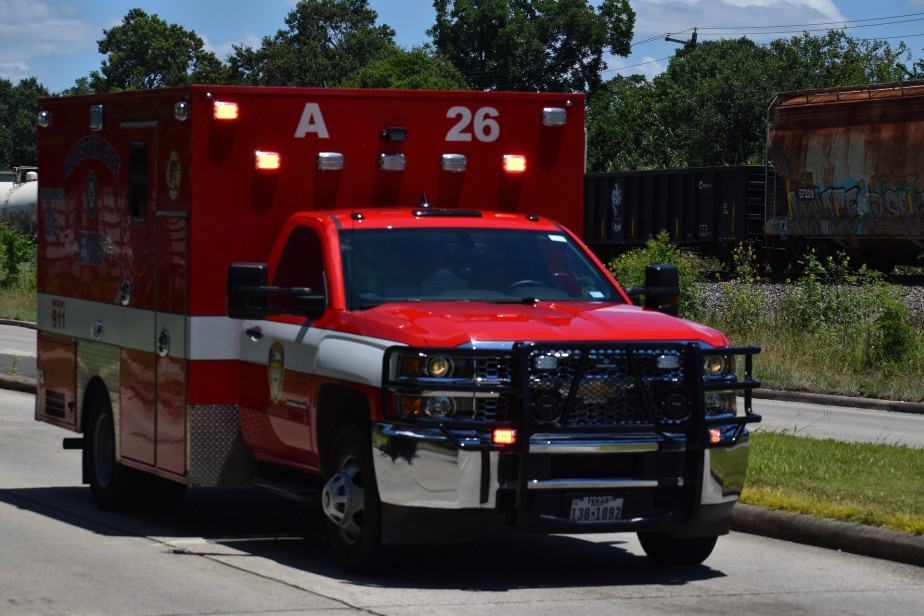Choosing the right career path for you is a life-altering decision, so it’s one you want to give plenty of consideration. Currently, you’re stuck between the ideas of working as an EMT or a paramedic. Are these two career paths really all that different? If so, how?
EMTs and paramedics both work in the medical field, but what an EMT can do in terms of administering life-saving procedures or medications differs from a paramedic. EMTs can use oxygen, glucose, and CPR treatments whereas paramedics can treat conditions with pacemakers, medications, and IV lines. Also, both fields require different levels of schooling.
In this article, we’ll explain the job roles of EMTs and paramedics in more detail. Then, we’ll go area by area, comparing EMTs and paramedics in job responsibilities, schooling, how to get into the field, earnings potential, and job outlook.
Table of Contents
What Is an EMT?
An emergency medical technician or EMT may be referred to as an ambulance technician as well.
This medical professional rides in or drives an ambulance, overseeing the transport of a patient in need of urgent medical care. An EMT can administer treatments and procedures that may save the life of the patient.

Most EMTs that earn that role have been trained and are certified, but in some instances, EMTs may not have certification.
They still must undergo a degree of schooling and training to get into the job, how much we’ll discuss a bit later.
Fire departments hire EMTs, as do hospitals, government agencies, municipal EMS agencies, and private ambulance companies.
Most EMTs who work this job are doing it and getting paid, but it’s not unheard of for some dedicated pros to donate their time and volunteer in an EMT capacity.
What Is a Paramedic?
What about paramedics?
If you’re a paramedic, you may also do your work on an ambulance, but not exclusively. As part of the emergency medical services or EMS team or first aid squad (FAST), a paramedic has more qualifications than that of an EMT, which is the main differentiating factor between them.
Since a paramedic is more qualified at their job, they can issue more treatments and procedures that may save the life of a patient.
Their level of expertise may stretch further than an EMT, in that a paramedic is educated in areas like medical procedures, which medications to administer and when, cardiology, physiology, and anatomy.
A paramedic may begin as an EMT and later become a paramedic, but not always.
Some paramedics get the schooling and training required to jump right into that field without ever having worked as an EMT first.
What Are the Job Responsibilities of an EMT vs. a Paramedic?
EMT Job Responsibilities
If you decide to pursue a career as an EMT, what kind of job responsibilities will be expected of you day in and day out?
As mentioned in the first section, most of your job will likely involve you riding in an ambulance.
When you reach the patient that needs care, you will have to evaluate and examine them. You will also have to determine what kind of care the patient needs in this moment before they reach the hospital.
You must have a strong knowledge of all the medical equipment and treatments available to you as an EMT so you can make an educated decision on which is best for the patient.
Then, you must document what the patient’s current condition is (such as an injury or illness), other pertinent information, which treatment you administered, and how the patient reacted.
It’s also crucial that you abide by patient confidentiality rules (better known as HIPPA) so that the patient can expect to have a degree of privacy when they’re in your care, even if they have yet to reach the hospital (or don’t have to because of your care, which can happen).
Not all EMTs will sit in the back of the ambulance with the patient, as we said. If you choose to take on this role, it may be your responsibility to drive the ambulance.
Operating an ambulance isn’t like driving a car or truck.

Not only must you have passed an Emergency Vehicle Operator Course or EVOC in many states before you can drive an ambulance, but the rules of the road are different.
For instance, in an emergency, you can bypass red lights and other stops. Still, you must be able to safely navigate the roads, drive at an even yet speedy pace, and not put other motorists’ lives at risk trying to transport your patient to the hospital or another medical facility.
Paramedic Job Responsibilities
As a paramedic, you may work as part of a small team with no more than two or three people. This ambulance crew will also comprise more seasoned medical workers, including senior members.
When an emergency strikes, as a paramedic, you’ll get there first, or very close to first. You’ll speak to friends, relatives, and witnesses to gather a picture of what happened.
Then, as you would as an EMT, you’ll quickly review the patient’s information and assess their current state to decide which treatment is most fitting for their condition.
You can do basic tasks like dress a wound, diagnose an injury or illness, and administer intravenous infusions, pain relief medications, and other meds.
You can also use more specialist medical equipment such as a defibrillator and/or a ventilator.
You will ride in emergency vehicles like ambulances, and in some instances, as a paramedic, you’ll also be expected to drive an ambulance. You’d bring the patient to the local hospital or medical facility so they can receive more care.
When you’re not working to help patients directly, you might train other budding EMTs or paramedics on the ins and outs of the job, such as how to use first aid. This teaching would be in an official capacity.
What Kind of Schooling Do You Need to be an EMT vs. a Paramedic?
EMT Education
Whether you decide a role as an EMT or a paramedic is better suited for you, either way, expect to undergo hundreds of hours of rigorous schooling to enter the field.
Also, if you’re looking for a list of EMT/Paramedic programs near you, check out our comprehensive list of EMT and Paramedic programs here.
At the very least, it’s recommended you start with a general education degree (GED) or a high school diploma if you don’t already have one.
Then you can begin earning your EMT certification. According to the National Registry of Emergency Medical Technicians or NREMT, earning your certification involves you passing two exams.
The first of these is a psycho-motor exam. During this exam, you will be quizzed on your knowledge in the following areas:
- Administering supplemental oxygen
- Performing mouth-to-mouth using supplemental oxygen
- Applying suction to the upper airway adjuncts
- Shock management
- Bleeding control
- Splinting
- Joint dislocation immobilization
- Long bone fracture immobilization
- BVM ventilation for apneic patients
- Cardiac arrest management
- Patient assessments
The second exam, the cognitive exam, includes upwards of 120 questions, including live items, at least 60 of these as well as a few pilot questions.

The exam lasts for two hours and requires your knowledge in these areas:
- EMS operations
- Gynecology
- Obstetrics
- Trauma care
- Resuscitation
- Cardiology
- Ventilation and respiration
Besides passing the above two tests, you also must commit to at least 120 hours of schooling to earn your EMT certification.
Don’t forget that in some states, you may need your EVOC or Emergency Vehicle Operator Course license that lets you drive an ambulance. The states that require an EVOC are as follows:
- Wyoming
- Missouri
- West Virginia
- Minnesota
- Virginia
- Kentucky
- Iowa
- Pennsylvania
- Oregon
- Hawaii
- Oklahoma
- Florida
- District of Columbia
- New Mexico
- Delaware
- Connecticut
- Nebraska
- Alabama
Paramedic Education
The training requirements are much more stringent if you want to become a paramedic. Rather than spend 120 hours or more on your training or education, you must dedicate between 1,200 and 1,800 hours in all.
That’s about two years.
There’s no way to fast-track earning your paramedic certification, by the way, so you must be willing to commit to the long haul.
You may be able to enroll in a paramedic training degree program at your local community college or university to get started.
It’s ideal if you have taken college courses on subjects like English, math, and biology and successfully passed these if you haven’t already, as many paramedic programs will demand you do so.
The NREMT also offers a national registered paramedics course that includes a psycho-motor and cognitive exam.
If you trained to become an EMT several years back through the NREMT, then the structuring of these courses will be familiar to you.
During your psycho-motor exam, you must excel in six areas.
These include the Integrated Out-Of-Hospital Scenario, Oral Station Case A, Oral Station Case B, Static Cardiology, Dynamic Cardiology, Trauma, and Patient Assessment.
The Integrated Out-Of-Hospital Scenario or IOOH involves an adult, geriatric, or pediatric patient. You will work with a partner who’s a pro paramedic to assess the condition of the patient, diagnose them, and administer the appropriate care. The entire scenario is simulated.
The Oral Stations may focus on areas like transport, field impressions, verbal reporting, interpersonal relations, patient management, patient assessments, and scene management.
Your cardiac management skills will also be put to the test. During the Static Cardiology part of the psychomotor exam, you have to successfully review several ECG tracings and then determine the voice and rhythm for each one.

The Dynamic Cardiology part of the exam includes you administering a treatment for a patient experiencing a cardiac arrest.
The Trauma section of your exam will review your skills in secondary assessments, history-taking, resuscitation, primary surveying, and sizing up the scene.
That’s just the psychomotor exam, by the way. Your cognitive exam involves you passing a computer adaptive test or CAT as well as your National Registry Paramedic or NRP exam.
You may have to answer up to 150 questions on the NRP test, including several live items (up to 130) and pilot questions.
You have two and a half hours to complete the test. You’ll be quizzed on areas such as:
- EMS operations
- Gynecology
- Obstetrics
- Trauma care
- Resuscitation
- Cardiology
- Ventilation and respiration
Remember, since one of your primary duties as a paramedic may be to drive the ambulance, if you don’t already have your license (the EVOC) and you need it in the state in which you work, then make sure you get that license.
How Much Money Can You Make as an EMT vs. a Paramedic?
EMT Salary
Before deciding what your working future will look like, you’ll want to take a peek into the financial outlook of the career field. What kind of money can you bring in as an EMT?
The U.S. Bureau of Labor Statistics or BLS lumps in EMTs and paramedics together. According to their official info, in 2019, an EMT or paramedic may earn $17.02 an hour or $35,400 per year.
We want to provide you the most detailed info as possible so you can make a smart career choice. Courtesy of ZipRecruiter, here’s an hourly and annual salary for EMTs per state in the US:
- North Carolina – $11.57 an hour, $24,072 a year
- Florida – $12.15 an hour, $25,281 a year
- Missouri – $12.44 an hour, $25,869 a year
- Mississippi – $12.47 an hour, $25,930 a year
- Alabama – $12.59 an hour, $26,195 a year
- Illinois – $12.61 an hour, $26,227 a year
- Arkansas – $12.68 an hour, $26,370 a year
- Michigan – $12.69 an hour, $26,390 a year
- New Mexico – $12.72 an hour, $26,457 a year
- Texas – $12.75 an hour, $26,514 a year
- Georgia – $12.90 an hour, $26,822 a year
- Iowa – $13.02 an hour, $27,090 a year
- Louisiana – $13.16 an hour, $27,372 a year
- Maine – $13.21 an hour, $27,483 a year
- Idaho – $13.22 an hour, $27,504 a year
- Oklahoma – $13.26 an hour, $27,582 a year
- Indiana – $13.28 an hour, $27,626 a year
- Utah – $13.30 an hour, $27,672 a year
- Kansas – $13.31 an hour, $27,684 a year
- Arizona – $13.37 an hour, $27,804 a year
- Wisconsin – $13.40 an hour, $27,862 a year
- Ohio – $13.43 an hour, $27,929 a year
- Montana – $13.51 an hour, $28,093 a year
- Colorado – $13.52 an hour, $28,114 a year
- Tennessee – $13.52 an hour, $28,131 a year
- Delaware – $13.53 an hour, $28,151 a year
- Oregon – $13.54 an hour, $28,155 a year
- Minnesota – $13.57 an hour, $28,223 a year
- South Carolina – $13.58 an hour, $28,249 a year
- Pennsylvania – $13.65 an hour, $28,396 a year
- West Virginia – $13.72 an hour, $26,534 a year
- New Jersey – $13.74 an hour, $28,569 a year
- South Dakota – $13.76 an hour, $28,631 a year
- Kentucky – $13.80 an hour, $28,699 a year
- Virginia – $14.08 an hour, $29,288 a year
- California – $14.14 an hour, $29,419 a year
- Wyoming – $14.17 an hour, $29,467 a year
- North Dakota – $14.18 an hour, $29,492 a year
- Nevada – $14.23 an hour, $29,604 a year
- Nebraska – $14.27 an hour, $29,677 a year
- Vermont – $14.29 an hour, $29,715 a year
- Alaska – $14.35 an hour, $29,838 a year
- Rhode Island – $14.36 an hour, $29,877 a year
- Connecticut – $14.48 an hour, $30,122 a year
- Maryland – $14.49 an hour, $30,131 a year
- Hawaii – $15.01 an hour, $31,,226 an hour
- New Hampshire – $15.21 an hour, $31,643 a year
- Washington – $15.52 an hour, $32,286 a year
- Massachusetts – $15.63 an hour, $32,513 a year
- New York – $15.78 an hour, $32,823 a year
Paramedic Salary
The same hourly and annual salary information for a paramedic is available courtesy of ZipRecruiter that breaks down the data state by state. Here it is:
- North Carolina – $16.83 an hour, $35,001 a year
- Florida – $17.67 an hour, $36,757 a year
- Missouri – $18.08 an hour, $37,612 a year
- Mississippi – $18.13 an hour, $37,701 a year
- Alabama – $18.31 an hour, $38,086 a year
- Illinois – $18.33 an hour, $38,133 a year
- Arkansas- $18.43 an hour, $38,342 a year
- Michigan – $18.45 an hour, $38,370 a year
- New Mexico – $18.49 an hour, $38,467 a year
- Texas – $18.53 an hour, $38,551 a year
- Georgia – $18.75 an hour, $38,999 a year
- Iowa -$18.94 an hour, $39,388 a year
- Louisiana – $19.13 an hour, $39,797 a year
- Maine – $19.21 an hour, $39,960 a year
- Idaho – $19.23 an hour, $39,990 a year
- Oklahoma – $19.28 an hour, $40,103 a year
- Indiana – $19.31 an hour, $40,167 a year
- Utah – $19.34 an hour, $40,234 a year
- Kansas – $19.35 an hour, $40,252 a year
- Arizona – $19.44 an hour, $40,426 a year
- Wisconsin – $19.48 an hour, $40,510 a year
- Ohio – $19.52 an hour, $40,607 a year
- Montana – $19.64 an hour, $40,846 a year
- Colorado – $19.65 an hour, $40,876 a year
- Tennessee – $19.66 an hour, $40,902 a year
- Delaware – $19.68 an hour, $40,931 a year
- Oregon – $19.68 an hour, $40,937 a year
- Minnesota – $19.73 an hour, $41,036 a year
- South Carolina – $19.75 an hour, $41,073 a year
- Pennsylvania – $19.85 an hour, $41,287 a year
- West Virginia – $19.95 an hour, $41,488 a year
- New Jersey – $19.97 an hour, $41,539 a year
- South Dakota – $20.01 an hour, $41,629 a year
- Kentucky – $20.06 an hour, $41,727 a year
- Virginia – $20.47 an hour, $42,584 a year
- California – $20.56 an hour, $42,774 a year
- Wyoming – $20.60 an hour, $42,844 a year
- North Dakota – $20.62 an hour, $42,881 a year
- Nevada – $20.69 an hour, $43,044 a year
- Nebraska – $20.74 an hour, $43,149 a year
- Vermont – $20.77 an hour, $43,204 a year
- Alaska – $20.86 an hour, $43,384 a year
- Rhode Island – $20.88 an hour, $43,440 a year
- Connecticut – $21.06 an hour, $43,796 a year
- Maryland – $21.06 an hour, $43,810 a year
- Hawaii – $21.83 an hour, $45,402 a year
- New Hampshire – $22.12 an hour, $46,007 a year
- Washington – $22.57 an hour, $46,943 a year
- Massachusetts – $22.73 an hour, $47,283 a year
- New York – $22.94 an hour, $47,724 a year
Is There Room for Advancement as an EMT vs. a Paramedic?
You just got hired as an EMT or paramedic. Will this be your job title for the foreseeable future or is there room for you to advance your career?
As an EMT, your goal should be to work your way up to the paramedic level. As you can see from reviewing the two sets of annual state income data from ZipRecruiter, in every state in the country, a paramedic far out-earns an EMT.
This is simply because a paramedic’s job is more advanced and requires more training.

Remember, you’ll have to dedicate at least two years of your life on training to become a paramedic, so you’ll have your EMT job for a while.
The skills you learn throughout your training to earn a certification will both come in handy now while you’re still an EMT as well as later when you officially work in the capacity of a paramedic.
As an EMT, you’re only the first tier, an EMT-Basic. Then, you’ll reach the second tier, EMT-Intermediate. The third tier is EMT-Paramedic.
What about once you earn that coveted title? As a paramedic, have you hit your glass ceiling, so to speak?
Not at all!
As a top-tier paramedic, you can go in all sorts of different job directions within the medical field. For example, you could become a physician’s assistant.
As a physician’s assistant, it’s your job to request tests for diagnostics, give a patient a prescription for medication, and even examine patients to determine what may be causing them pain or illness.
You do need at least a master’s degree to work as a physician’s assistant. The annual salary for this job title is $95,000 to $130,000 a year, so it’s certainly a pay bump!
You could also look into working as a dispatcher, instructor, operations manager, administrative director, or paramedic supervisor. There’s no limit to the branching career paths your job as a paramedic can take you!
What’s the Career Outlook as an EMT vs. a Paramedic?
According to the BLS, in 2018, the US had 262,100 EMT and paramedic jobs. Between 2018 and 2028, the field is expected to add on 18,700 more jobs for a job growth rate of 7 percent.
That’s quicker than average compared to other industries, says the BLS.
If you’re looking for a career path with job security and longevity, working as an EMT or paramedic are two great jobs.
There will always be people getting sick or injured, which means there’ll always be a need for your job.
Conclusion
EMTs and paramedics share similar roles, such as assessing and diagnosing patients, administering medications, and driving an ambulance.
That said, paramedics can offer more advanced treatments on the spot because the job requires two extra years of training compared to working as an EMT.
Appropriately, you earn more money as a paramedic.
Hopefully this article enlightened you and will help you choose your next exciting career path. Best of luck!